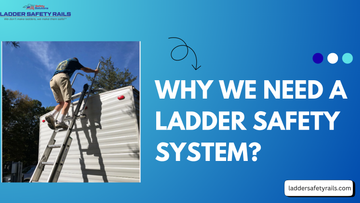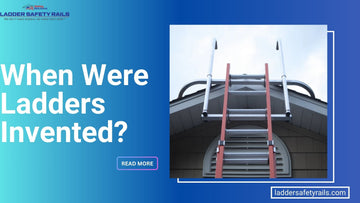
Working from heights might look simple from the ground, but anyone who’s ever climbed a ladder knows, one wrong move and things can go wrong. A ladder safety system isn’t just an accessory; it’s an essential piece of gear that can protect you from serious injury or worse.
Whether you're cleaning gutters, managing a warehouse, or climbing a fixed ladder on a commercial rooftop, there's one constant: gravity. And spoiler alert, it always wins. That’s why many homeowners, contractors, and facility managers are investing in modern ladder safety systems to climb smarter, not harder.
Let’s dig into why you should never climb without one, and what options are out there to keep your feet on the rungs and your body off the ground.
The Rising Need for Ladder Safety
Climbing a ladder might seem straightforward, but here’s the reality check: according to the CDC, more than half a million people in the U.S. suffer from ladder-related injuries every year. Many of those falls happen from heights as low as 6 to 10 feet. It doesn't take a tall ladder to cause a serious injury, just one bad step.
This makes ladder safety devices a must-have. We’re talking everything from ladder stabilizers that keep you steady on uneven ground to ladder safety rails that give your hands something solid to grip when you climb. If you’re climbing to a roof without a ladder stabilizer for roof work, you’re gambling with your life.
The need for ladder safety isn’t just growing; it’s necessary. As buildings go taller and projects become more complex, we need better tools and safer practices. A ladder safety system offers both.
What Is a Ladder Safety System?
At its core, a ladder safety system is exactly what it sounds like: a setup designed to keep you safe while climbing. But let’s break that down a bit.
Many systems include a mix of hardware and personal protective equipment. That could mean a climbing harness connected to an anchor point, ladder safety rails that can guide your climb, or a vertical lifeline system built into a fixed ladder. It might also include fall arrest gear or simple add-ons like ladder stabilizers to keep your base from shifting mid-task.
You’ll often find comprehensive fixed ladder safety systems in commercial and industrial spaces, such as water towers, silos, or high-rise maintenance ladders. But don’t think this is just for professionals only. Homeowners using extension ladders should also consider ladder safety devices to prevent slips and topples.
These systems don’t just protect you; they boost your confidence. When you know your gear has your back, you're less likely to rush or make a critical mistake. And that, ironically, gets the job done faster and better.
Types of Ladder Safety Devices You Should Know
Not every task calls for the same safety gear. That’s why there’s a wide range of ladder safety devices available, tailored for different uses and environments. Knowing what’s out there can help you pick the right setup and climb with peace of mind.
Let’s go over a few key types:
-
Fall Arrest Systems: Usually, part of a fixed ladder safety system, these setups include a harness, lanyard, and a vertical lifeline or rail. If you slip, the system “catches” you before a serious fall. It's like a seatbelt, but for climbing.
-
Ladder Stabilizers: These wide attachments go at the top of your ladder and extend its contact area, reducing side-to-side wobble. A ladder stabilizer for roof work is a must if you’re climbing onto shingles or soft edges.
-
Ladder Safety Rails: Think of these as built-in handrails. Some ladders come with them, or you can add them. They help you stay balanced and reduce the chance of overreaching.
-
Ladder Cages and Enclosures: Found in industrial setups, these protect you from falling backward while climbing a fixed ladder. They’re like vertical tunnels that surround your climb.
Each of these ladder safety systems plays a unique role. When used correctly, they create multiple layers of protection, and that's exactly what you want when your feet leave the ground.
Read more blog: What Is a Ladder Roof Stabilizer and Why Every Roofer Needs One?
Ladder Stabilizers: The Unsung Heroes of Climbing Safety

Here’s a simple truth: most ladder accidents happen as the ladder moves. Enter the ladder stabilizer, one of the most overlooked yet incredibly effective ladder safety devices out there.
These attachments are designed to give your ladder a wider, more secure footprint. Instead of two little feet pressing into the ground or siding, a stabilizer ladder provides extra contact points. That means less wobble, more control, and far fewer heart-stopping moments when you're halfway up a wall.
And if you’re doing roof work? A ladder stabilizer for roof jobs isn’t just nice, it’s essential. It protects your gutters and shingles from dents or scrapes and gives you a safe launch point when climbing on or off the roof.
Here’s the important note: stabilizers are lightweight, affordable, and easy to attach. Yet many people skip them because they don’t realize how big a difference they make. Don’t be that person. Use one. Your future self will thank you.
Why Fixed Ladder Safety Systems Are a Must-Have for Commercial Use?
If you manage a facility or work in an industrial setting, fixed ladders are part of your daily work. But if those ladders don’t include a fixed ladder safety system, you're walking a very risky line, not just legally, but ethically.
OSHA requires fall protection on any ladder over 24 feet. That means a complete ladder safety system with vertical lifelines, harnesses, and secure anchor points. These setups help ensure that if someone slips or loses grip while climbing, they do not fall.
More than compliance, though, it’s about responsibility. Providing the right safety gear shows you value your workers’ health and are serious about minimizing risks. And guess what? Workers who feel safe also work more efficiently and confidently.
A good fixed ladder safety system can also save you thousands in legal fees, insurance claims, and downtime. It’s a small investment with massive returns.
Extension Ladder Safety Tips You Should Never Ignore
Extension ladders are incredibly handy; you can lean them on the side of a house, extend them to reach rooftops, and fold them up when you're done. But they’re also one of the most dangerous tools if used not properly.
Here are some practical ladder safety tips for extension ladders:
-
Inspect Before Every Use: Check for cracks, loose rungs, and corrosion. Damaged ladders can be a hazard.
-
Set the Right Angle: The 4:1 rule matters. For every 4 feet of height, the base should be 1 foot out from the wall.
-
Stabilize the Ladder: A ladder stabilizer adds peace of mind and makes climbing safer, especially on slick or uneven ground.
-
Secure the Base: Don’t let your ladder slide out. Use ladder feet on grass, mats on concrete, or tie it off.
-
Never Overreach: Always keep your belt buckle between the side rails. Move the ladder instead of leaning too far.
Pairing these tips with a ladder safety system makes your setup rock-solid. You’ll work more efficiently, with fewer “uh-oh” moments.
Common Mistakes That Put Ladder Users at Risk

Even experienced workers fall into bad habits. Here are some of the most common and dangerous ladder mistakes:
-
Skipping the Pre-Climb Check: Rushing to start without inspecting your ladder is a fast track to injury. Always check for structural damage and test the balance.
-
Using the Wrong Ladder for the Job: Climbing too high on a short ladder or using a ladder on the wrong surface is asking for trouble.
-
Overreaching: This is probably the number one cause of ladder falls. If you find yourself stretching to reach, it’s time to climb down and reposition.
-
Ignoring Safety Add-Ons: If your ladder didn’t come with ladder safety rails, stabilizers, or other supports, add them. They exist for a reason.
The biggest mistake? Assuming you are too experienced to fall. The more confident you are, the easier it is to get complacent. A reliable ladder safety system acts as your safety net when your instincts fail.
How Ladder Safety Systems Save Time and Lives?
Sometimes safety gear can indeed feel like a hassle. Straps, anchors, stabilizers. It’s tempting to skip it when you're in a rush. But here’s the truth: ladder safety systems can actually save you time in the long run.
Why? Because accidents take time. A fall might cost you weeks off work, hours of paperwork, or permanent physical limitations. The few minutes it takes to set up a safety ladder system is nothing compared to the consequences of a fall.
Plus, modern ladder safety devices are built for efficiency. Quick-attach stabilizers, comfortable harnesses, and easy-slide rails make the process smoother than ever. And when you're confident in your gear, you work faster, focus better, and finish safer.
So yes, safety takes time, about five minutes. But injury recovery? That could take five months.
Final Thoughts
Climbing a ladder is part of everyday work for millions of people, but that doesn’t mean it’s safe by default. Whether you're a contractor scaling a rooftop or a homeowner changing a lightbulb, a ladder safety system is your best ally in avoiding unnecessary risks.
Ladder falls are quick and brutal. Prevention is slow and smart. Choose smart, choose Ladder Safety Rails for the extra stability and protection you deserve. Stay safe, work confidently, and make every climb secure.
FAQs
-
What is the golden rule of ladder safety?
The golden rule is simple: always maintain three points of contact, two hands and one foot, or two feet and one hand, when climbing or descending. This core principle is embedded in every reliable ladder safety system.
-
What is the biggest cause of ladder accidents?
The main cause is using the wrong ladder or using it incorrectly. For example, placing an extension ladder at too steep or too shallow an angle.
-
What is one of the biggest mistakes when using a ladder?
Overreaching. It throws off your balance and increases your chance of tipping. Always reposition your ladder, and if you're using a ladder stabilizer, it is much easier.
-
What four things would you check on a ladder before using it?
-
Condition – Cracks, rust, or damaged feet.
-
Stability – Make sure the base is solid and level.
-
Height – Use a ladder tall enough for the task.
-
Safety equipment – Confirm all ladder safety devices, like rails or harnesses, are in place and secure.
Read More Related Blog:

What Are The Essential Safety Equipment for Extension Ladder Users?



